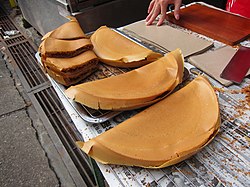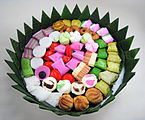|
Apam balik
Apam balik (lit. 'turnover pancake'; Jawi: أڤم باليق) also known as martabak manis (lit. 'sweet murtabak'),[3] terang bulan (lit. 'moonlight'), peanut pancake or mànjiānguǒ (Chinese: 曼煎粿), is a sweet dessert originating in Fujian cuisine which now consists of many varieties at specialist roadside stalls or restaurants throughout Brunei, Indonesia, Malaysia and Singapore.[4] It can also be found in Hong Kong as (Chinese: 冷糕), Taiwan as (Chinese: 麥仔煎), Southern Thailand as Khanom Thang Taek (ขนมถังแตก) and in the Sulu Archipelago, Philippines as Tarambulan. Origins
The origins of Apam balik / 曼煎粿 attributes its invention to Zuo Zongtang, a military leader of the late Qing dynasty. In 1855, the army of the Taiping Heavenly Kingdom invaded the Fujian region and General Zuo was appointed to lead an army to crush the rebels. To provide the soldiers with food without interfering the life of local people, General Zuo decided to switch from the flatbread which was eaten together with spring onion and chilli sauce, to a pancake that used locally sourced and mass-produced ground cane sugar and peanut as filling.[5] The recipe does seem to have spread throughout the Fujian region, especially around Quanzhou and later on throughout Southeast China. It was brought south into Southeast Asia or Nanyang by Hokkien and Teochew immigrants, especially to Singapore, and merchants spread it to neighbouring regions.[1] In Indonesia, Martabak manis originated from the Bangka Belitung Islands by ethnic Chinese (Hokkien and Khek) and it was named “Hok Lo Pan” which translates to “Hok Lo ethnicity’s cake.”[6] Its traditional topping includes sugar and sesame seeds. Martabak manis have different names in different regions. In West Borneo, it is called Apam pinang, similar to Malaysia's Apam balik. In Central Java, Martabak manis is referred to as “Kue Bandung” which means Bandung cake.[6] The origin of Kue Bandung started when a man from Bangka Belitung, opened a Martabak manis stall beside a “Bandung Noodle” stall.[6] Other namesThe dessert is also known by various names in different languages, depending on the region. Indonesia
Malaysia and Singapore
Brunei
ChinaHong Kong
Singapore
Taiwan
Philippines
DescriptionThe pancake's batter is made from a mixture of flour, eggs, sugar, baking soda, coconut milk and water.[7] The batter is cooked upon a thick round iron frying pan in plenty of palm margarine to avoid it sticking to the pan. Then other ingredients are sprinkled as filling; the most common or traditional is crushed peanut granules with sugar and sweetcorn kernels (available from cans), but modern innovations such as chocolate sprinkles and cheddar cheese are also available.[7] Then, the pancake is folded (hence the name: "turnover pancake") and cut into several pieces.[12] In Indonesia there is a smaller version made with smaller pan, they are called martabak mini or terang bulan mini. The texture of the apam balik can vary depending on the amount of batter and type of pan used, from one that is akin to a crispier form of crumpets to small thin light pancake shells that break when bitten (the latter is usually called apam balik nipis, 'thin apam balik'). There is a Peranakan variant, the apom balik, that closely resembles the Indonesian Serabi.
See alsoReferences
|
|||||||||||||||||||||||||||








